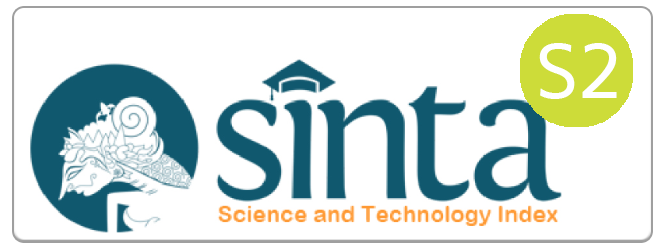State Land Management for Orderly Administration of Land in Regencies/Cities
Abstract
The concept of state control over land is the underlying concept of land management in Indonesia, which is physically represented by the state land. The control of the utilization of state land is one of the sub-activities of the regency/city government. However, there has been no study on these sub-activities carried out based on the Regulation of the Minister of Home Affairs Number 90 of 2019, Law on Job Creation and its derivatives, and the concept of land administration. This paper presents the results of the study on state land management in regencies/cities. This study was conducted using content several methods: content analysis, secondary data analysis, and classification analysis based on the concept of land administration. The data collected and analyzed were laws and regulations on land and their implementation in the context of land administration in several areas in Indonesia. The results of this study indicate that there are fundamental changes in the definition of state land, where the Law on Job Creation and its derivatives do not define land that has been attached to land rights as state land. In addition, the Regulation of the Minister of Home Affairs Number 90 of 2019 and the Law on Job Creation and its derivatives have regulated the authority of the regency/city government in the administration of the control, use, development, and assessment of state land. By considering the definitions and laws and regulations regarding state land, state land management can be implemented through (1) the development of the state land cadaster system, (2) coordination with the agencies administering the control of state land, and (3) the regulation and implementation of the use, development, and assessment of state land.
Keywords: land administration, regency/city, state land
Downloads
References
Alexander, F. S. (2015). Land Banks and Land Banking (2nd Edition). Center for Community Progress.
Al-Zahra, F. (2017a). Gagasan Pengaturan Bank Tanah untuk Mewujudkan Pengelolaan Aset Tanah Negara yang Berkeadilan. Jurnal Ilmiah Administrasi Publik, 3(2), 92–101. https://doi.org/10.21776/ub.jiap.2017.003.02.2
Al-Zahra, F. (2017b). Konstruksi Hukum Pengaturan Bank Tanah untuk Mewujudkan Pengelolaan Aset Tanah Negara Berkeadilan. Arena Hukum, 10(3), 357–384. https://doi.org/10.21776/ub.arenahukum.2017.01003.2
Al-Zahra, F. (2019). Konstruksi Hukum Pengaturan Bank Tanah Untuk Mewujudkan Pengelolaan Aset Tanah Negara Berkeadilan. Keadaban, 1(1), 18–48.
Blanco, A. G., Moreno, N., Vetter, D. M., & Vetter, M. F. (2016). The Potential of Land Value Capture for Financing Urban Projects: Methodological Considerations and Case Studies. https://doi.org/10.18235/0000597
Bryman, A. (2012). Social Research Methods (4th Edition). Oxford University Press.
Budiman, A. (2020). Pensertifikatan Tanah Negara oleh Masyarakat Menjadi Tanah Hak Milik. Jurnal Hukum Dan Kenotariatan, 4(2), 158–172.
Dale, P., & McLaughlin, J. D. (1988). Land Information Management: An Introduction with Special Reference to Cadastral Problems in Third World Countries. Oxford University Press.
Dale, P., & McLaughlin, J. D. (1999). Land Administration. Oxford University Press.
Dewanti, A. N. (2013). Pemberian Hak Atas Tanah dari Tanah Negara Menjadi Tanah Hak Milik Atas Rumah Dinas Bagi 17 Pegawai PT PLN yang Telah Pensiun di Kabupaten Ungaran. Notarius, 4(1), 23.
Dunn, W. (1998). Pengantar Analisis Kebijakan Publik. Gadjah Mada University Press.
Enemark, S. (2004, October 26). Building Lang Information Policies. UN, FIG, PC IDEA Inter-Regional Special Forum on the Building of Land Information Policies in the Americas.
FIG. (1998). The FIG Statement on the Cadastre. FIG.
Harsono, B. (2013). Hukum Agraria Indonesia: Sejarah Pembentukan Undang-Undang Pokok Agraria, Isi, dan Pelaksanaannya. Penerbit Universitas Trisakti.
Holsti, O. R. (1969). Content Analysis for the Social Sciences and Humanities. Addison-Wesley.
Ismail, F. K. (2013). Pendayagunaan Tanah Negara Bekas Tanah Terlantar Melalui Program Reformasi Agraria. Lex Jurnalica, 10(2), 121–134.
Jade, A. P., Putri, D. N., & Al-Fatih, S. (2020). Perizinan Membuka Tanah Negara di Kota Balikpapan. Supremasi Hukum, 29(2), 102–130.
Lawry, S., Samii, C., Hall, R., Leopold, A., Hornby, D., & Mtero, F. (2014). The Impact of Land Property Rights Interventions on Investment and Agricultural Productivity in Developing Countries: a Systematic Review. Campbell Systematic Reviews, 10(1), 1–104. https://doi.org/10.4073/csr.2014.1
Limbong, D. (2017). Tanah Negara, Tanah Terlantar dan Penertibannya. Jurnal Mercatoria, 10(1), 1–9.
Mujiburohman, D. A. (2016). Problematika Pengaturan Tanah Negara Bekas Hak yang Telah Berakhir. Bhumi, 2(2), 151–164.
O’Shaughnessy, J. (1973). Inquiry and Decision. Harper & Row.
Rochaeni, A. (2019). Penertiban Tanah Terlantar dan Pendayagunaan Tanah Negara Bekas Tanah Terlantar di Indonesia. Jurnal Ilmiah Magister Administrasi, 13(1).
Santoso, U. (2010). Pendaftaran dan Peralihan Hak Atas Tanah. Kencana Prenada Media Group.
Sapriadi. (2015). Redistribusi Tanah Negara Obyek Landreform dalam Mendukung Program Reforma Agraria di Kabupaten Sumbawa. Jurnal IUS, 3(8), 364–381.
Sembiring, J. (2016). Pengertian, Pengaturan, dan Permasalahan Tanah Negara (Edisi Revisi). Prenadamedia Group.
Sembiring, R. (2017). Hukum Pertanahan Adat. Rajawali Press.
Sullam, M., & Jarot. (2011). Proses Pembuatan Sertipikat Atas Tanah Negara Menjadi Hak Milik Akibat Peralihan Jual Beli di Kantor Pertanahan Kota Jakarta Barat. Lex Jurnalica, 8(2), 100–126.
Tampang, G. J. (2017). Pendaftaran Tanah Negara Menjadi Hak Milik Dalam Perspektif Hukum Pertanahan di Indonesia. Lex Administratum, 5(4), 110–116.
Williamson, I., Enemark, S., Wallace, J., & Rajabifard, A. (2011). Land Administration for Sustainable Development. ESRI Press.
Copyright (c) 2022 Rizqi Abdulharis, Ida Nurlinda, Ari Zakaria, Alfita Puspa Handayani

This work is licensed under a Creative Commons Attribution-ShareAlike 4.0 International License.












